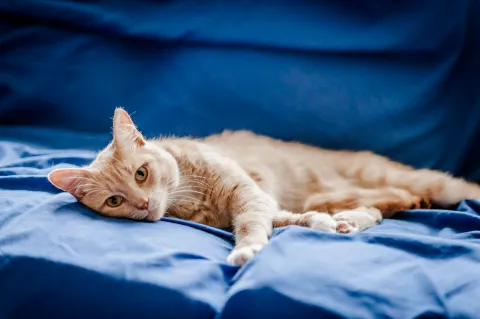: The Feline Reproductive Mystery: How Many Times Can a Cat Get Pregnant?

The feline world is rife with mysteries, and one intriguing aspect is the frequency with which cats can become pregnant. Cat owners and enthusiasts often find themselves pondering this question, curious about the reproductive capabilities of their beloved feline companions. In this article, we will unravel the complexities surrounding how many times a cat can get pregnant and delve into the factors that influence their reproductive cycles.
Understanding Feline Reproduction: Before exploring the frequency of cat pregnancies, it’s essential to understand the basics of feline reproduction. Cats are known for their prolific breeding tendencies, and their reproductive system is finely tuned for efficiency. Female cats, or queens, typically reach sexual maturity around six months of age, although this can vary among different breeds and individual cats.
The Estrous Cycle: Female cats experience an estrous cycle, commonly known as being in heat. Unlike humans, cats do not have a regular menstrual cycle but instead go through a series of stages during estrus. The feline estrous cycle typically lasts around 21 days, during which a cat can display various behaviors indicating receptivity to mating.
How Many Times Can a Cat Get Pregnant? The number of times a cat can get pregnant is influenced by several factors, including age, health, and environmental conditions. On average, a healthy and fertile cat can experience multiple pregnancies throughout her life. The number can range from 1 to 3 litters per year, with each litter consisting of 4 to 6 kittens, although variations exist.
Age and Reproductive Lifespan: A cat’s reproductive lifespan depends on various factors, but age is a crucial determinant. Younger cats are generally more fertile, and their ability to conceive may decrease with age. While some cats may continue to have successful pregnancies into their senior years, the likelihood diminishes. On average, a cat’s peak reproductive years are between one and eight years old.
Health Factors: The health of a cat plays a significant role in its reproductive capabilities. Cats that are well-nourished, receive proper veterinary care, and live in a stress-free environment are more likely to have successful pregnancies. Conversely, cats with underlying health issues or inadequate nutrition may experience difficulties conceiving or carrying a pregnancy to term.
Environmental Factors: The environment in which a cat lives can impact its reproductive behavior. Cats in outdoor or feral populations may have more frequent pregnancies due to the absence of controlled breeding measures. Indoor cats, on the other hand, may have fewer opportunities to mate unless intentional breeding is facilitated by their owners.
Spaying and Neutering: One of the most effective ways to control the number of times a cat can get pregnant is through spaying and neutering. These surgical procedures prevent unwanted pregnancies and offer several health benefits, including a reduced risk of certain cancers and behavioral improvements. Many veterinarians recommend spaying or neutering cats at an early age to curb overpopulation and enhance the overall well-being of the animal.
The Dangers of Frequent Pregnancies: While cats are biologically designed for frequent pregnancies, it’s crucial to consider the potential risks associated with excessive breeding. Continuous pregnancies can lead to health issues for both the mother and her kittens. Malnutrition, exhaustion, and an increased susceptibility to infections are among the concerns associated with frequent pregnancies. Responsible breeding practices and proper veterinary care are essential to ensure the well-being of the cat and her offspring.
Conclusion: The question of how many times a cat can get pregnant is a multifaceted one, influenced by factors such as age, health, and the environment. While cats are biologically inclined to reproduce frequently, responsible pet ownership involves understanding and managing their reproductive capabilities. Spaying and neutering, along with providing proper care and nutrition, play pivotal roles in maintaining the health and happiness of feline companions. By approaching feline reproduction with knowledge and responsibility, cat owners can contribute to the well-being of their beloved pets and mitigate the challenges associated with uncontrolled breeding.
How many times can a cat get pregnant in a year?
-
- On average, a healthy and fertile cat can experience multiple pregnancies in a year, ranging from 1 to 3 litters annually. The specific frequency may vary based on factors such as age, health, and environmental conditions.
At what age can a cat start getting pregnant?
- Female cats, or queens, typically reach sexual maturity around six months of age. However, this can vary among different breeds and individual cats. It’s essential to monitor their behavior for signs of being in heat, indicating they are ready for mating.
Can older cats still get pregnant?
- Yes, older cats can still get pregnant, but the likelihood of successful pregnancies may decrease with age. A cat’s peak reproductive years are generally between one and eight years old. While some cats may continue to have successful pregnancies in their senior years, the chances diminish.
Are there health risks associated with frequent pregnancies in cats?
- Yes, frequent pregnancies can pose health risks for both the mother cat and her kittens. Potential issues include malnutrition, exhaustion, and an increased susceptibility to infections. Responsible breeding practices, proper veterinary care, and monitoring the cat’s health are crucial to mitigate these risks.
What factors influence a cat’s ability to conceive?
- Several factors influence a cat’s ability to conceive, including age, health, and environmental conditions. Well-nourished cats living in a stress-free environment with proper veterinary care are more likely to have successful pregnancies.
How can I control the number of times my cat gets pregnant?
- Spaying and neutering are highly effective ways to control the number of times a cat can get pregnant. These surgical procedures prevent unwanted pregnancies and offer various health benefits, including a reduced risk of certain cancers and behavioral improvements.
What is the feline estrous cycle, and how long does it last?
- The feline estrous cycle, commonly known as being in heat, typically lasts around 21 days. During this cycle, a cat may display various behaviors indicating receptivity to mating, such as increased vocalization, restlessness, and affectionate behavior.
Can indoor cats get pregnant?
- Indoor cats can get pregnant if they have access to outdoor environments or if intentional breeding is facilitated by their owners. However, by keeping indoor cats in a controlled environment and considering spaying or neutering, owners can prevent unplanned pregnancies.
What are the benefits of spaying or neutering my cat?
- Spaying (for females) and neutering (for males) offer several benefits, including preventing unwanted pregnancies, reducing the risk of certain cancers, and improving behavioral issues such as aggression and roaming.
At what age should I spay or neuter my cat?
- Many veterinarians recommend spaying or neutering cats at an early age, typically around six months. However, the optimal age can vary, so it’s essential to consult with a veterinarian to determine the best timing for your cat based on individual health and circumstances.
- Spaying (for females) and neutering (for males) offer several benefits, including preventing unwanted pregnancies, reducing the risk of certain cancers, and improving behavioral issues such as aggression and roaming.
- Indoor cats can get pregnant if they have access to outdoor environments or if intentional breeding is facilitated by their owners. However, by keeping indoor cats in a controlled environment and considering spaying or neutering, owners can prevent unplanned pregnancies.
- The feline estrous cycle, commonly known as being in heat, typically lasts around 21 days. During this cycle, a cat may display various behaviors indicating receptivity to mating, such as increased vocalization, restlessness, and affectionate behavior.
- Spaying and neutering are highly effective ways to control the number of times a cat can get pregnant. These surgical procedures prevent unwanted pregnancies and offer various health benefits, including a reduced risk of certain cancers and behavioral improvements.
- Several factors influence a cat’s ability to conceive, including age, health, and environmental conditions. Well-nourished cats living in a stress-free environment with proper veterinary care are more likely to have successful pregnancies.
- Yes, frequent pregnancies can pose health risks for both the mother cat and her kittens. Potential issues include malnutrition, exhaustion, and an increased susceptibility to infections. Responsible breeding practices, proper veterinary care, and monitoring the cat’s health are crucial to mitigate these risks.
- Yes, older cats can still get pregnant, but the likelihood of successful pregnancies may decrease with age. A cat’s peak reproductive years are generally between one and eight years old. While some cats may continue to have successful pregnancies in their senior years, the chances diminish.
- Female cats, or queens, typically reach sexual maturity around six months of age. However, this can vary among different breeds and individual cats. It’s essential to monitor their behavior for signs of being in heat, indicating they are ready for mating.
- On average, a healthy and fertile cat can experience multiple pregnancies in a year, ranging from 1 to 3 litters annually. The specific frequency may vary based on factors such as age, health, and environmental conditions.






